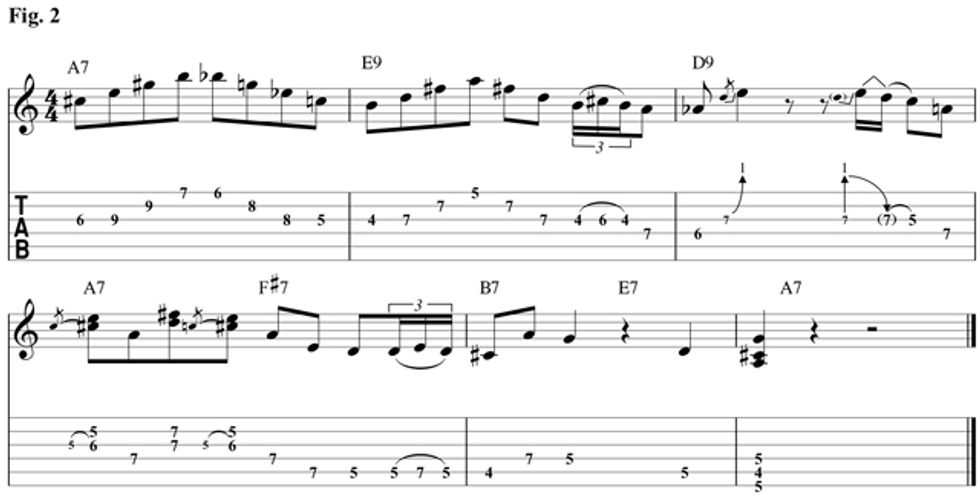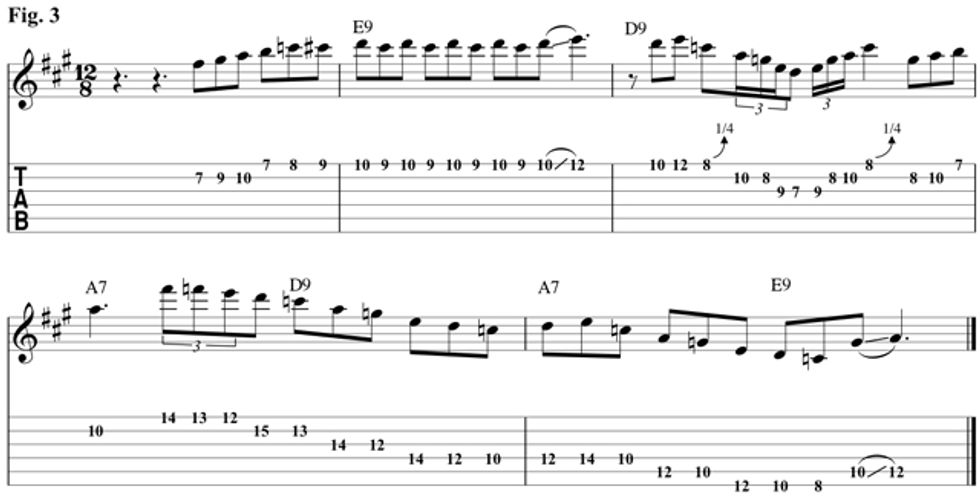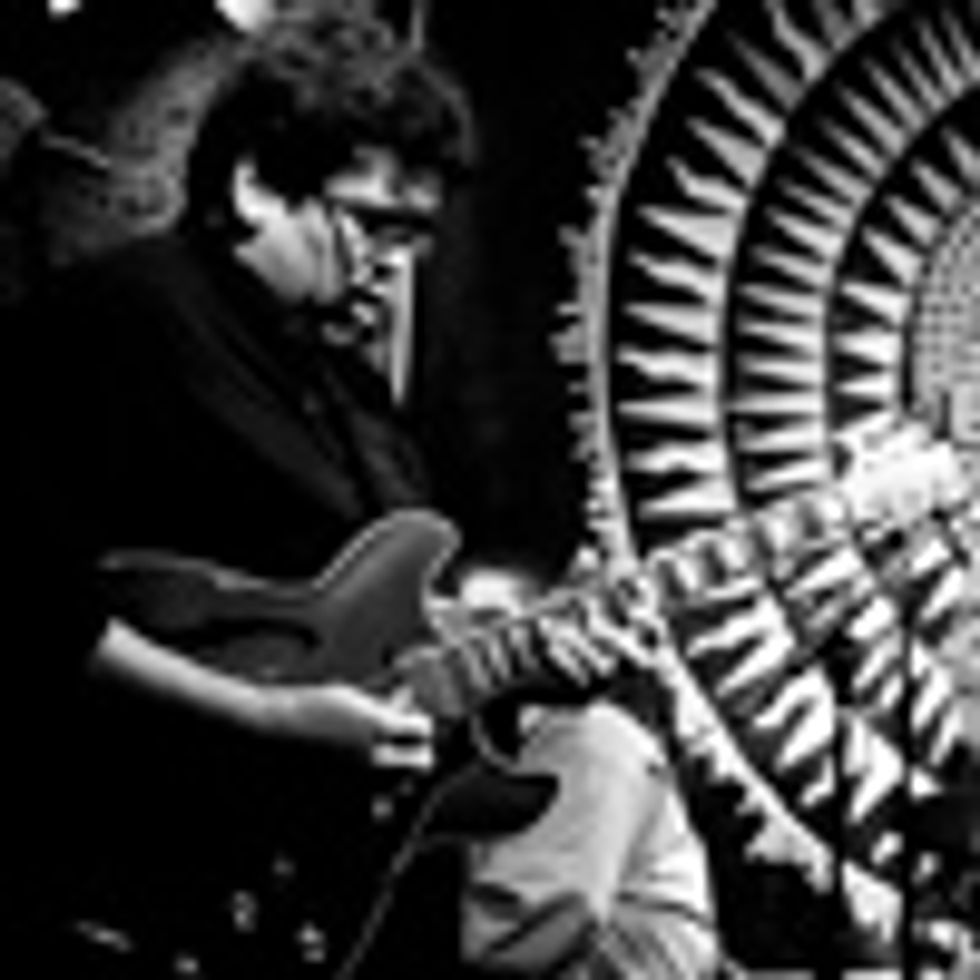Chops: Intermediate
Theory: Intermediate
Lesson Overview:
• Learn turnarounds in the style of Robben Ford, Matt Schofield, and Larry Carlton.
• Understand how to incorporate open strings into traditional phrases.
• Create tension in your improvisations by anticipating the chord changes.
Click here to download the notation and audio files from this lesson.
In this column we’re going to take a look at three turnaround licks from three modern masters—Robben Ford, Matt Schofield, and Larry Carlton. Turnarounds are an essential part of any guitarist’s vocabulary, so you can never have enough of them in your bag. To make things easy, we will keep them all in the key of A.
Let’s start with a turnaround in the style of Robben Ford (Fig. 1). This is primarily from the A minor pentatonic scale (A–C–D–E–G). We’re going to use the first position of the scale and incorporate some open strings. Robben is great at modernizing classic blues licks and this is a fine example of his approach. This lick pretty much follows the chords with the root movement, and then ends with a very traditional turnaround that we’ve played before. We have the root on the top string as the bass chromatically descends from G to E.

For the next turnaround (Fig. 2), we move to one of the newest British blues masters, Matt Schofield. I’ll warn you—this turnaround takes a bit of getting used to, but once your ears adjust to the sound, it’ll be great. Anticipating chords is a great way to create tension in your soloing. We’ll start this lick out on A7 by playing phrases that connect triads with chromatic passing tones.

We begin by using the Bb half-whole diminished scale (Bb–B–C#–D–E–F–G–Ab) over the first two beats and then connect to an Eb major triad (Eb–G–Bb). Using a major triad based off the b5 of the chord gives us some interesting chord tones. In this case, we have a b5 (Eb), b7 (G), and a b9 (Bb).
When you look at the chord tones Schofield uses over the first two beats, you’ll realize he is anticipating the chords by a full measure and then using chromatic notes to resolve the tension in the second measure. Jazz musicians work backwards beat by beat to develop their ears to be able to anticipate the chords like this. We’ll be a whole measure ahead of the chords. Over the I–VI7–II7–V7 chords in the last two measures, he takes it easy with a cool bend and a resolution to the 3 (C#) of A7, and then the b7 (G). The chord voicing in the last measure is really cool—a nice A7 with just the root (A), the 3 (C#), and the b7 (G).
The last turnaround (Fig. 3) is in the style of Larry Carlton. This is a very difficult lick that is played over a slow 12/8 blues. I tried to slow this one down as much as I could. Really spend some time listening to the phrasing of this lick. If it makes it easier, break it down into sections. This turnaround starts with a lick that anticipates the V chord over the I chord by using an A major scale (A–B–C#–D–E–F#–G#) to create a run that leads us to the E9.

Next there’s a phrase that emphasizes the b7 (D) of the V chord. As the chord changes to D9, he plays a simple A minor lick and then lands on the b7 (C) of the IV. Then we move into a more triplet-based lick and finally resolve by landing on the root. In the fourth measure we start a descending run that uses the 4th position of the A minor pentatonic scale.
I hope you enjoy these turnarounds and I hope you make them a part of your regular blues vocabulary. Take your time to get the sound of these new turnarounds in your ears. At first, some of the notes I’ve asked you to play may sound harsh and unnatural but if you keep using them your ears will develop a liking to them and hopefully your listeners will enjoy your newfound tensions.
 Dennis McCumber has been a guitar instructor and performer
for more than 20 years. He holds a Bachelor’s degree in music
education from The College of Saint Rose.
Dennis performs
regularly in the New York City area with various rock, blues, and funk bands, and occasionally as a classical soloist.
In addition to performing, Dennis has been a middle school
music teacher in the Bronx for the past 12 years. While
teaching in the Bronx, he was given a guitar lab by VH1
Save the Music and a keyboard lab from the radio station
Hot97 Hip Hop Symphony. Dennis has been an instructor at
the National Guitar Workshop since 1996, where he teaches
Blues, Funk, and Rock. Find out more at dennismccumber.com.
Dennis McCumber has been a guitar instructor and performer
for more than 20 years. He holds a Bachelor’s degree in music
education from The College of Saint Rose.
Dennis performs
regularly in the New York City area with various rock, blues, and funk bands, and occasionally as a classical soloist.
In addition to performing, Dennis has been a middle school
music teacher in the Bronx for the past 12 years. While
teaching in the Bronx, he was given a guitar lab by VH1
Save the Music and a keyboard lab from the radio station
Hot97 Hip Hop Symphony. Dennis has been an instructor at
the National Guitar Workshop since 1996, where he teaches
Blues, Funk, and Rock. Find out more at dennismccumber.com.









![Rig Rundown: Russian Circles’ Mike Sullivan [2025]](https://www.premierguitar.com/media-library/youtube.jpg?id=62303631&width=1245&height=700&quality=70&coordinates=0%2C0%2C0%2C0)






